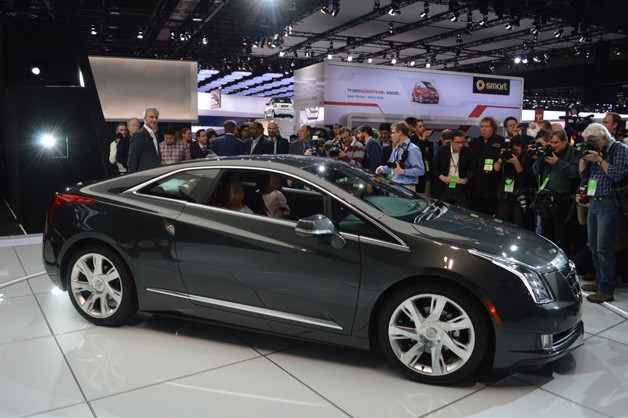The Volt electric car has been a fizzle for GM – and that’s putting it kindly. Only a small handful have sold – and that’s putting it euphemistically, given the massive subsidies that went into building it and the equally massive incentives ($7,500 a pop at the federal level, not counting state-level payola) that have proved necessary to get anyone to “buy” one.
So what does GM do?
It builds an even more expensive Volt – the $75,000 (to start) Cadillac ELR.
Not surprisingly, even fewer of these electric Edsels have found “buyers” – notwithstanding the almost $10k in other-people’s-money that’s held under the nose of prospects as an inducement.
How few?
As of early July, only 300 suckers have lined up so far. About six per state.
This makes the Volt seem like a best-seller. GM has managed to unload a few thousand of them.
The unfolding debacle redux shouldn’t surprise anyone. The Volt hasn’t sold much because its high price (almost $40k last year – deeply discounted to about $35k this year) defeats its purpose. Well, its alleged purpose. Or rather, the only sane purpose for building – let alone buying – one of these things: Significantly lowering your cost to get around by significantly reducing the quantity of gas you have to buy. Isn’t that the object of this exercise?
But if the car itself costs a small fortune, who cares how little gas it uses? Even if gas prices double, the math isn’t favorable. Financially speaking, you’d be much better off buying a $16k economy car that gets 40 MPG rather than a $35k Volt that hardly uses any gas at all (even if that were true – and it’s not true).
No sale.
Well, few sales.
There will always be a handful of people for whom money’s a secondary consideration, who will buy a car like the Volt – or the ELR – because they like it for other reasons than economic reasons. Maybe they like its looks. Or they think the technology is “cool” – regardless of its cost.
But an electric car or hybrid that costs 50 percent (or 200 percent) more than an otherwise comparable gas-burner does not compute for people who base their buying on economic considerations – which is most people. In particular, people who shop hybrids and electrics.
GM isn’t the only car company that’s done the Gerry Ford falling down the steps routine, either.
The plug-in version of the otherwise big-selling Toyota Prius has sold not-so-much. Because a Prius that makes economic sense at just over $24k makes a lot less sense at nearly $30k (the base price of the plug-in version).
A Volt at $35k makes even less sense.
So how much sense does the $75k ELR make?
And the Volt, at least, has four doors – and seats four realistically. It’s a hatchback, too – so there’s room for people’s stuff as well as people. Notwithstanding its priciness, the Volt could plausibly serve as a family’s main car. 
The ELR, on the other hand, is a two-door coupe that seats four unrealistically. It has a purse-sized 10 cubic foot trunk. It is hopeless as a family car.
And ridiculous as an economy car.
Even if it cost nothing to operate (and it costs more than you’d expect to operate) the fact that it costs more than a Porsche Cayman S, a Lexus LS or and nearly as much as a Mercedes S-Class makes any discussion of the ELR’s economic bona fides as absurd as a singing mime or a stud eunuch. I could punch a hole in the gas tank of my ’76 Trans-Am and the thing would still be a less expensive means of getting from A to B than an ELR.
But does it work as a luxury car?
I guess – if you don’t mind paying $75k (call it $68k, after Uncle “rebates” you $7,500 of other people’s money) to go slower than a $16k Corolla – and not nearly as far.
The ELR lugs itself to 60 in about 9 seconds; a Corolla gets there a few tenths sooner than that.
This ought not to be surprising given the Corolla has a more favorable power-to-weight ratio. Its 1.8 liter gas-burning engine only makes 132 hp – but there’s only 2,800 pounds of Corolla to pull. The ELR has 157 hp on tap – slightly more than the Corolla. But there’s 4,050 pounds of Cadillac around its neck.
The ELR is the slowest Cadillac GM has built in years. It also happens to be the most expensive Cadillac you can buy right now.
If you don’t mind being outrun by $16k Corollas.
And not just 0-60.
A new Corolla can go about 500 miles (on the highway) before you’ll need to pull off for five minutes or so to refill its 13.2 gallon tank. The ELR can go about 37 miles before its batteries are drained to the point that the on-board generator (a small gas engine not connected to the drive wheels) kicks in to keep the car moving. If you want to run on electricity-only again (you know, to “save gas”) you’ll need to stop for 4-5 hours to recharge the batteries from an external power source. If you have access to a 240 Volt external power source, that is. Otherwise, it’s overnight (or all day) for a standard household 115 Volt outlet.
Nothing more luxurious than waiting on line for hours to “refuel” while everyone else is getting to where they’re going.
Right?
I despise the Tesla for being rent-seeking on wheels, but at least it moves. Maybe not for long. But – for one or two quick bursts, before its batteries wilt – it’ll run with elite high-performance luxury-sport gas burners like the BMW M5. I’ll give it that.
But the ELR doesn’t go far, takes forever (relative to even the humblest gas burner) to re-juice itself- and it’s slow, on top of that.
Tell me again: Why would anyone in possession of his senses buy this car?
Exactly.
But GM couldn’t see it – and went ahead and did it. I’m not sure why, but two possible explanations come to mind – neither of them pretty:
One, GM is run by idiots. People who read the market like Captain “EJ” Smith piloted Titanic. There is plenty of evidence that this could be the case. The same people who commissioned the ELR signed off on the Aztek, after all. Or at least, some of them – and the same corporate types. The egregious ignition switch mess provides another case in point. Yeah, let’s keep on putting those known defective switches into cars . . . fingers crossed, no one will ever know.
Two, GM is run by crony capitalists of the first magnitude; people who make Boris Yeltsin look like a free market kind of guy. This explanation makes much more sense to me. The guys – and gals – on the top floor of the Renaissance Center understand politics as much as top car managers once knew engineering and marketing. The ELR – and Volt – derive from political considerations. They are “green” and help GM show a sunny, “earth friendly” corporate visage to the public. It doesn’t hurt that the federal government pays handsomely (in other people’s money) to subsidize the manufacturer of cars like the Volt and ELR.
GM is not the only company cashing in, either. It’s a proverbial feeding frenzy and – in a crony capitalist/rent-seeking economy – such perverse incentives drive product development as much or more as authentic market signals.
Buyers may not be interested in cars like the Volt or the ELR. But that doesn’t mean there isn’t money to be made in making them.
GM is not run by stupid people.
Throw it in the Woods?
We depend on you to keep the wheels turning. If you value alternatives to the MSM, please support independent media. Our donate button is here.
For those not Pay Pal-inclined, you can mail us at the following:
EPautos
721 Hummingbird Lane SE
Copper Hill, VA 24079











Assuming one pays more than $7500 annually in federal income tax, the Volt is $27,500 after taxes (in California, $26,000) – not out of line for a family sedan.
And battery warranties are 8-10 years, not 5, nor do replacement battery packs cost $10,000 – for the pack itself it’s around $3,000 for the Volt.
And please, there’s nothing “toxic” about a nickel-metal hydride or lithium battery pack.
Nor are “rare earths” critical – Tesla doesn’t use them in their EVs.
Hi Bill,
I won’t argue over “rare earth” stuff, nor over battery longevity. The stake through the heart is the Volt’s absurdity on economic grounds. Why not just have the federal government give $7,500 of other people’s money to people who buy $15k non-hybrid cars? Their cost to drive would be so much less!
When you were describing who runs GM I kept picturing James Taggart from Rand’s book Atlas Shrugged.
Dang! Owen! Great analogy!
Eric, you’ve hit another homer: “Hybrids are more political than economic.”
What’s particularly irksome about “political” products is that they take time, money, and energy away from real solutions to real problems and products that people actually want.
As you’ve mentioned before, CNG cars would make a helluva lot more sense than hybrids, if you’re looking for more economical and cleaner driving:
1. They burn a clean, inexpensive fuel that we’ve got lots and lots of right here in the USA (in fact, we can capture the gas from garbage). Plus, we have natural gas pipelines almost everywhere, and most people have gas heat, stoves, water heaters, etc. so they can be set up to fill up at home.
2. They can go as long or longer between fill-ups/charges as gasoline/hybrid/electric cars, and don’t take hours to recharge.
3. They don’t require extensive changes to today’s proven powertrain designs.
4. They don’t need limited-range batteries that contain toxic metals that are mined in China, and don’t contribute to our toxic waste problems.
5. They have comparable speed/power/range/overall capability to gasoline and diesel engines.
6. Although you have to worry about gas leaks and some other safety issues (just like with gasoline and diesel fuel), CNG vehicles won’t electrocute rescue squads (or electrocute YOU) in a wreck, won’t have major battery fires, or corrosive leaks on the ground.
So why don’t we see more CNG vehicles?
Personally, I think that they’re TOO simple and cheap a solution to be appealing. Governments and businesses almost always take the complicated and expensive route.
Bryce, you hit the mark. GM’s been making CNG light trucks for 2-3 years but with a sticker hickey that doesn’t make sense. I know the tank and lines for the fuel cost a big more but not to the tune of what is added on.
I have a ’68 4020 John Deere that just kept running beyond the life of hour meters. No telling how many hours it has but it’s Timex all the way, just keeps on ticking. Pull the plugs, clean as a whistle. It looks like hell but busts off and gens on demand.
I realize truck and car bodies and everything in them, on them and under them wouldn’t hold up like this but they should be long terms trucks. I work in the patch in Tx. and every location we build has a pipeline around at least two sides. But they have plans to ship all that NatGas to Europe and make big bucks best I can figure. Then they can charge bigger bucks for it here too.
Even if the price was the same as gasoline or diesel, I never see a station to fill them.
The local dealer in St. Petersburg, FL, has been running advertising for the 2013 and 2014 Volts at $18,777 because they are used. They are taking the tax credit, $7500, and other discounts off the sticker price. After all the fees, taxes, add-ons, and trade-in, my co-worker walked out with one at $17,000 last month and has not used the gas yet.
http://www.maherchevrolet.com/WeeklyAd?siteMapItemName=3119901268424351968
He expects to save $300 per month in gas, more then enough to cover the payments. He can charge at home and work.
Crazy!
Hi Kevin,
For awhile (and it may still be available) GM was offering $199/month lease deals for two years on the thing… a giveaway. Just to get them of the lot.
I think that’s the point, if the Volt’s price were cut in half, then it starts to make sense to buy one.
And if I could charge a car for free at work I’d probably consider such a vehicle. That’s an untaxed increase in salary.
Yup.
At around $22k – even $25k – the Volt can make a case for itself (on economic grounds). This is why the Prius sells. Its cost to buy is low enough – or rather, close enough to comparable gas-only cars – that its over-the-road savings on fuel quickly closes the gap and makes owning one worthwhile.
But at $35k, it’s doubtful the car will ever save you money. Unless you’re comparing it with other $35k cars. In which case, fine. But people who can afford to spend $35k on a car are not really sweating the cost of gas….
But does the Prius make sense for Toyota, economically in the long run?
The story you always hear, is that revenue wise, the Prius at best breaks even or loses money per unit sold because they cannot sell it for a higher price since the market won’t allow it. So lots of their other Toyota gas powered cars and trucks end up subsidizing it.
I know they have made the decision to sell the Prius for other reasons (green politics, good “will” etc) then money, but you can’t sell an entire line of vehicles at a loss or break even point for very long, even with deep pockets.
It takes resources (time, money, R & D) from their bread and butter which are Corolla and Camry. Even the Tundra likely brings far more profit revenue then the Prius. Toyota has lost some of its one time, fire proof, “quality reputation”, are vehicles like the Prius distracting Toyota from its main line and profitable vehicles?
What are your thoughts on that end of the economy of autos? Will we drive the long term profit margins out of even foreign brands like we have for the most part with American automakers.
Quite so, Rich.
Toyota has been able to “float” the Prius because the company’s other cars have sold very well – and there’s money to spare (or rather, losses can be absorbed).
I’m sure they hope (internally) that technology breakthroughs (in particular, battery storage breakthroughs) will transform the Prius from a political product into an economic one.
But for now, it’s like “diversity.” Every car company has to at least pretend that hybrids are “the future” and have at least one in the product portfolio. Else risk being accused of “not caring about the environment” – the car industry equivalent of “racism.”
With the average new car selling around $32k, the Volt at $35k isn’t as implausible a purchase as you might think.
My main problem with the Volt wasn’t the technology or the price, but the car body itself – the ergonomics are horrible. As in 90’s Oldsmobile bad.
Cadillac has fixed that with the ELR – the layout and controls are now mainstream and not all wonky like the Volt. But at $75k? Heck no. I could buy a used XLR convertible (originally sold over $100k) for less and have a much better time driving it.
Found a 2007 XLR near me for $40k with only 36 thousand miles on it. That’s half the ELR *and* it comes with a Corvette-derived powertrain. Just have to hope the electro-pneumatic top never breaks…
Your observation about crony capitalism/rent-seeking is spot on. As a registered Republican, one of my major beefs with the Republican Party is that being “pro-business” means that they support, condone, or at least ignore, crony capitalism.
That said, I strongly disapprove of governments telling businesses what products to make/services to provide, how to make/provide them, who to hire, who to sell to, how they should be run, etc. But remember this: Big Business (BB) is just as big a threat to your freedom as Big Government (BG).
What’s more, contrary to popular belief, BB and BG are bosom buddies. BG uses BB to provide its revenue stream, carry out its edicts (Halliburton, anyone?) and push its ideology. BB useds BG as its junkyard dog to protect its turf from competition with laws, regulations, etc. BB only supports free markets when they work in THEIR favor. When they don’t, they call on BG to rig the game in their favor.
GM’s a lost cause if they continue this track, but only when the grabbermint changes hands and stops the green fascism.
Besides, electric motor and battery technology isn’t above golf cart capability as yet. Battery technology has advanced a long way in the last 20 years (as I’ve seen through my model plane hobby) but motor design is the main hobble, because any time you turn metal through a magnetic field it generates electricity – but it opposes the force you’re trying to create. Every electric motor is also a generator.
Any normal electric motor is already working against some 25% force before it’s even connected to a drivetrain and, if it uses electromagnets for the field coils instead of permanent neodymium (expensive), then it uses even more power just keeping the magnetic field going.
At this point in time electric cars need to be all battery and no luxury, no boot or glove box. Expecting to keep 2 tons of metal and add-ons (including the mandated ones) moving for any length of time with current (pun not intended) electric motor design is chasing unicorn farts, not forgetting having to replace the battery when it dies every 5 years or so – that’ll be 10 grand thanks..